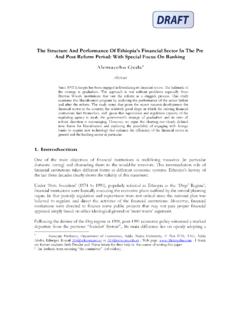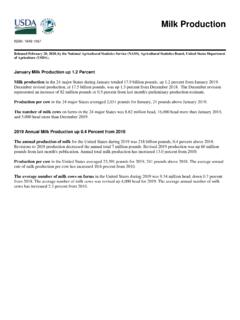Transcription of Taxes and Tax Reform in Ethiopia, 1990-2003
1 Copyright UNU-WIDER 2005 1 Department of Economics, Addis Ababa University, ethiopia , email: and 2 Department of Economics, University of G teborg, Sweden, email: This study has been prepared within the UNU-WIDER project on Tax Policy Reform in Developing Countries. UNU-WIDER gratefully acknowledges the financial contribution to the project by the Royal Danish Ministry of Foreign Affairs, Danida. UNU-WIDER also acknowledges the financial contributions to the research programme by the governments of Denmark (Royal Ministry of Foreign Affairs), Finland (Ministry for Foreign Affairs), Norway (Royal Ministry of Foreign Affairs), Sweden (Swedish International Development Cooperation Agency Sida) and the United Kingdom (Department for International Development).
2 ISSN 1810-2611 ISBN 92-9190-753-7 (internet version) Research Paper No. 2005/65 Taxes and Tax Reform in ethiopia , 1990-2003 Alemayehu Geda1 and Abebe Shimeles2 December 2005 Abstract In 1991 the Ethiopian Revolution Democratic Front (EPRDF) toppled the old socialist regime that had ruled the country for seventeen years. In contrast to the previous policy regime of hard control, EPRDF initiated a wide range of reforms that covered not only the tax system but also the exchange rate, interest rates, trade, domestic production and distribution. This paper attempts to explore the contribution of the tax Reform , the changes in its structure and institutional Reform in order to understand its role in raising revenue.
3 Keywords: tax Reform , fiscal policy, distribution of income, incidence analysis, ethiopia , Africa JEL classification: D1, D3, D6, E6, H0, H2, H4 The World Institute for Development Economics Research (WIDER) was established by the United Nations University (UNU) as its first research and training centre and started work in Helsinki, Finland in 1985. The Institute undertakes applied research and policy analysis on structural changes affecting the developing and transitional economies, provides a forum for the advocacy of policies leading to robust, equitable and environmentally sustainable growth, and promotes capacity strengthening and training in the field of economic and social policy making.
4 Work is carried out by staff researchers and visiting scholars in Helsinki and through networks of collaborating scholars and institutions around the world. UNU World Institute for Development Economics Research (UNU-WIDER) Katajanokanlaituri 6 B, 00160 Helsinki, Finland Camera-ready typescript prepared by T:mi LHR Editorial and Secretarial Assistance The views expressed in this publication are those of the author(s). Publication does not imply endorsement by the Institute or the United Nations University, nor by the programme/project sponsors, of any of the views expressed.
5 Acknowledgement We would like to thanks our friends Aleme Abreha, Getachew Adem and Anmew Ebye for their help in accessing and processing of the data used in this study. Any errors are our own. 1 1 Introduction In ethiopia the year 1991 marked the end of the previous policy regime of hard control that had lasted for nearly two decades. This was the year when the seventeen-year old socialist regime was toppled by the coalition of rebel forces, the Ethiopian Revolution Democratic Front (EPRDF), which formed the current government.
6 Starting from 1992, the EPRDF has initiated a wide range of reforms that can be termed as liberalization. Reform of the tax system was among the range of liberalization polices that also extended, among others, to the exchange rate, interest rates, trade, domestic production and distribution. After the 1992 liberalization, investment grew rapidly. But this increasing level of investment could not be financed by domestic resources alone. Savings declined sharply in 1990/1 (a period of violent change in the government). Since then, there has been some recovery, only to decline further by the end of the 1990s.
7 Public saving has shown quite a remarkable recovery in the 1990s. Thus, in this respect the government s fiscal policy seems However, total domestic saving was far below the level of investment, and this resulted in a government deficit of about 10 per cent of GDP per annum in the last decade (see Geda 2005). The current government has registered modest achievement in terms of fiscal policy, chiefly through revenue generation, but this is being frustrated by the war with Eritrea and the natural disasters of the recent past. The deficit also points to the country s dependence on external resource in bridging its resource gap.
8 This is more obvious in the financing of government capital expenditure than anywhere else (Geda 2005). Current expenditure is largely financed by government revenue, which is a positive development. For instance, external assistance constituted on average only 8 per cent of the total recurrent expenditure during the period 1985/6 to 1990/1. This figure rose sharply to 12 per cent in 1991/2 but dropped to an average of 3 per cent for the period 1991/2-97/8. On the other hand, in financing capital expenditure, the external sector accounts for approximately 20 per cent in terms of loans and around 10 per cent in terms of assistance.
9 An interesting development for this period was the sharp rise in the treasury financing of capital expenditure that grew from around 50 per cent at the beginning of the 1990s to about 70 per cent at the end of the decade a commendable achievement (see Geda 2005) which might have something to do (in particular) with the tax Reform being carried in ethiopia . This paper attempts to explore the contribution of the tax Reform , the changes in its structure and institutional Reform in order to understand its role in raising revenue (sections 2 and 3).
10 However, as this might have distributional implications, we examine this issue using incidence analysis (section 4). Section 5 concludes the paper. 1 A simple regression suggests in ethiopia the possibility of crowding-in. 2 2 A chronology of the main tax reforms, 1990-2003 An over view of the tax system and the tax Reform The first major change in ethiopia s tax system was initiated in the post-Second World War period (between 1942-44), the years 1947-52 covering its second stage. These changes were generally discretionary, including amendments to property Taxes (land and cattle).




